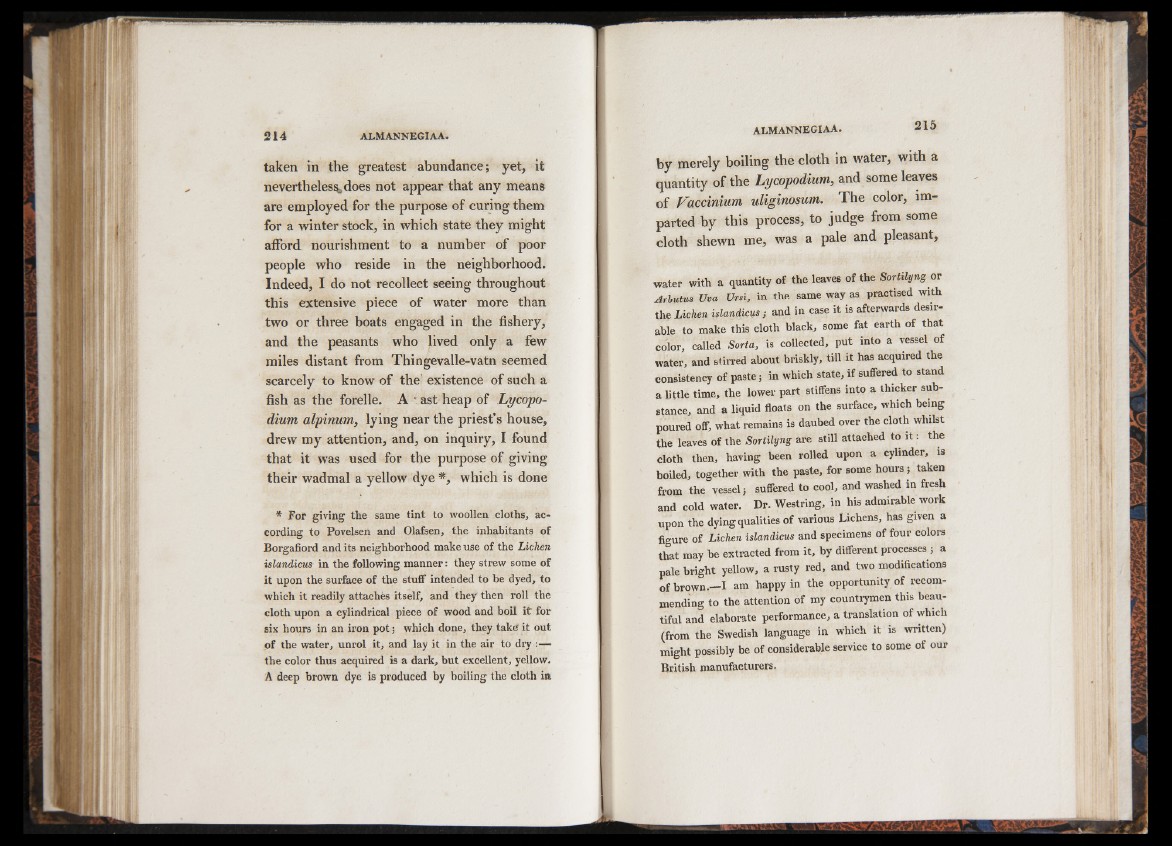
taken in the greatest abundance; yet, it
nevertheless does not appear that any means
are employed for the purpose of curing them
for a winter stock, in which state they might
afford nourishment to a number of poor
people who reside in the neighborhood.
Indeed, I do not recollect seeing throughout
this extensive piece of water more than
two or three boats engaged in the fishery,
and the peasants who lived only a few
miles distant from Thingevalle-vatn seemed
scarcely to know of the’ existence of such a
fish as the forelle. A i ast heap of Lycopodium
alpinum, lying near the priest’s house,
drew my attention, and, on inquiry, I found
that it was used for the purpose of giving
their wadmal a yellow dye *, which is done
* For giving the same tint to woollen cloths, according
to Povelsen and Olafsen, the inhabitants of
Borgafiord and its neighborhood make use of the Lichen
islandicus in the following manner : they strew some of
it upon the surface of the stuff intended to be dyed, to
which it readily attachés itself, and they then roll the
cloth upon a cylindrical piece of wood and boil it for
six hours in an iron pot 5 which done, they take it out
o f the water, unrol it, and lay it in the air to dry
the color thus acquired is a dark, but excellent, yellow.
A deep brown dye is produced by boiling the cloth in
by merely boiling the cloth in water, with a
quantity of the Lycopodium, and some leaves
of Vaccinium uliginosum. The color, imparted
by this process, to judge from some
cloth shewn me, was a pale and pleasant,
water with a quantity of the leaves of the Sortilyngor
Arbutus Uva Ursi, in the same way as practised with
the Lichen islandicus ¡ and in case it is afterwards desirable
to make this cloth black, some fat earth of that
color, called Sorta, is collected, put into a vessel of
water, and stirred about briskly, till it has acquired the
consistency of paste; in which state, if suffered to stand
a little time, the lower part stiffens into a thicker substance,
and a liquid floats on the surface, which being
poured off, what remains is daubed over the cloth whilst
the leaves of the Sortilyng are still attached to i t : the
cloth then, having been rolled upon a cylinder, is
boiled, together with the paste, for some hours; taken
from the vessel; suffered to cool, and washed in fresh
and cold water. Dr. Westring, in his admirable work
upon the dying qualities of various Lichens, has given a
figure of Lichen islandicus and specimens of four colors
that may be extracted from it, by different processes; a
pale bright yellow, a rusty red, and two modifications
of brown.—I am happy in the opportunity of recommending
to the attention of my countrymen this beautiful
and elaborate performance, a translation of which
(from the Swedish language in which it is written)
might possibly be of considerable service to some of our
British manufacturers.